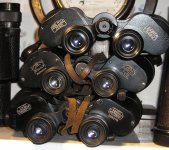jaymoynihan
Corvus brachyrhynchos watcher
At a flea market this a.m., I picked up a pair of Selsi " lightweight Amber Coated 525' @ 1000 yards Luminous" 7x35. All metal, very well built. Not the best eye relief but it does have roll down eye-cups. Came with the original case, and do not think it was used much. A piece of gold thread was still attached holding a plastic badge that says "extra wide angle binoculars". strap attached. Inspection stickers intact. Gold plastic eyepiece and objective covers.
They are surprisingly good, optically. I do not get the full 10 degrees, having to wear glasses, but I do get I estimate about 8.5.
Not bad for $3.:t:
They are surprisingly good, optically. I do not get the full 10 degrees, having to wear glasses, but I do get I estimate about 8.5.
Not bad for $3.:t:
Last edited:





